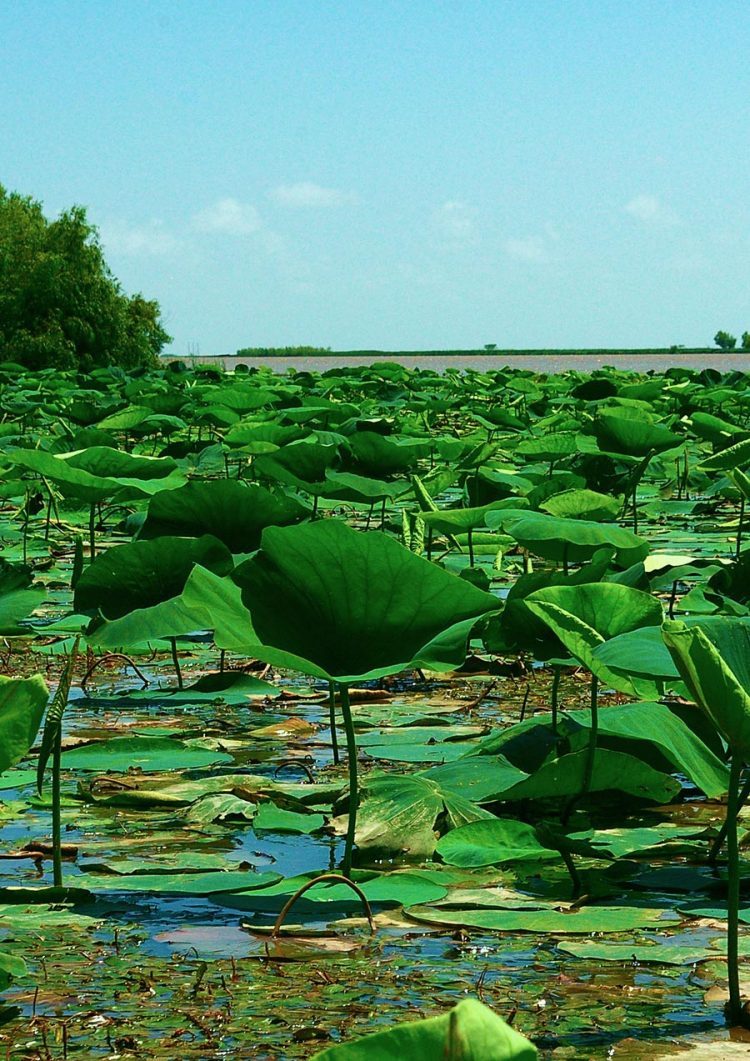'Just Right' Plant Growth May Make River Deltas Resilient

Elizabeth Olliver, Indiana University This image shows freshwater marsh vegetation in Wax Lake Delta, La. Aquatic vegetation on low-elevation marshes is pictured in the foreground, while woody vegetation occupies a levee on the left. The open water in the distance is a deltaic distributary channel.
The study, “Optimum vegetation height and density for inorganic sedimentation in deltaic marshes,” was published online Aug. 24 by Nature Geoscience. The findings may help guide restoration of river deltas, such as those near the mouth of the Mississippi River, which are under threat as sea levels rise.
Authors are William Nardin, a postdoctoral fellow in the Department of Geological Sciences in the IU Bloomington College of Arts and Sciences; and Douglas A. Edmonds, who holds the Robert R. Shrock Professorship in Sedimentary Geology and is an assistant professor of geological sciences.
Vegetation on marsh surfaces in river deltas can slow the flow of water and cause more sediment to be deposited, helping prevent sea-level rise from drowning sensitive marshlands. But the study finds that, if the vegetation is too tall or dense, it diverts water into the river channel, resulting in less sediment being deposited on the marsh.
“In river deltas the effect of vegetation on sedimentation seems to follow the Goldilocks principle,” Edmonds said. “You want the amount of vegetation that is just right — not too much, but also not too little.”
The world’s river deltas are rich and productive and are home to about 10 percent of the world’s population. But they are threatened by an array of forces, including population growth, pollution, development and erosion, as well as sea-level rise associated with climate change.
Edmonds wrote in a 2012 Nature Geoscience article that river deltas can be restored, but it will take a better understanding of the processes involved in their formation and destruction. The current study suggests vegetation could play a role in designing effective river delta restoration.
In tidal saltwater marshes, research has shown that vegetation enhances sedimentation. But scientists know less about how vegetation affects sedimentation in freshwater marshes that are common in river deltas. Nardin and Edmonds used sophisticated computer modeling to study how marsh vegetation influences the transport and deposition of sediment in river deltas. They conducted 75 simulations involving varying scenarios of vegetation height and density and rates of water flow.
They found that vegetation of intermediate height and density results in the greatest deposition of sand and mud. However, if the plants are too tall or densely packed, sediment tends to remain in the river channel, bypassing marshes and being carried directly to the sea.
The researchers also analyzed remote-sensing data collected from Wax Lake Delta in Louisiana. The analysis showed the delta exhibits a hydrodynamic response to the presence of vegetation that corresponds with what the researchers found with their model.
The rate at which sediment is delivered to marshes in river deltas is strongly influenced by storms and flooding, as well as the construction of engineered diversions. The research suggests the resilience of river deltas will depend on the timing of floods and storms relative to the seasonal growth of vegetation. And of course, scientists can’t control or even predict when floods will occur.
“That unpredictability adds an interesting twist to the problem,” Edmonds said. “The time that the flood wave arrives does not always coincide with the timing of vegetation growth and decay. Those two have to line up just right for vegetation to really enhance deposition of sand and mud.”
Funding for the research came from a National Science Foundation Frontiers in Earth Systems Dynamics grant and from the Alfred P. Sloan Foundation. To speak with Edmonds or Nardin, contact Steve Hinnefeld with IU Communications, 812-856-3488 or slhinnef@iu.edu.
Media Contact
More Information:
http://www.iu.eduAll latest news from the category: Earth Sciences
Earth Sciences (also referred to as Geosciences), which deals with basic issues surrounding our planet, plays a vital role in the area of energy and raw materials supply.
Earth Sciences comprises subjects such as geology, geography, geological informatics, paleontology, mineralogy, petrography, crystallography, geophysics, geodesy, glaciology, cartography, photogrammetry, meteorology and seismology, early-warning systems, earthquake research and polar research.
Newest articles

Properties of new materials for microchips
… can now be measured well. Reseachers of Delft University of Technology demonstrated measuring performance properties of ultrathin silicon membranes. Making ever smaller and more powerful chips requires new ultrathin…

Floating solar’s potential
… to support sustainable development by addressing climate, water, and energy goals holistically. A new study published this week in Nature Energy raises the potential for floating solar photovoltaics (FPV)…

Skyrmions move at record speeds
… a step towards the computing of the future. An international research team led by scientists from the CNRS1 has discovered that the magnetic nanobubbles2 known as skyrmions can be…




















